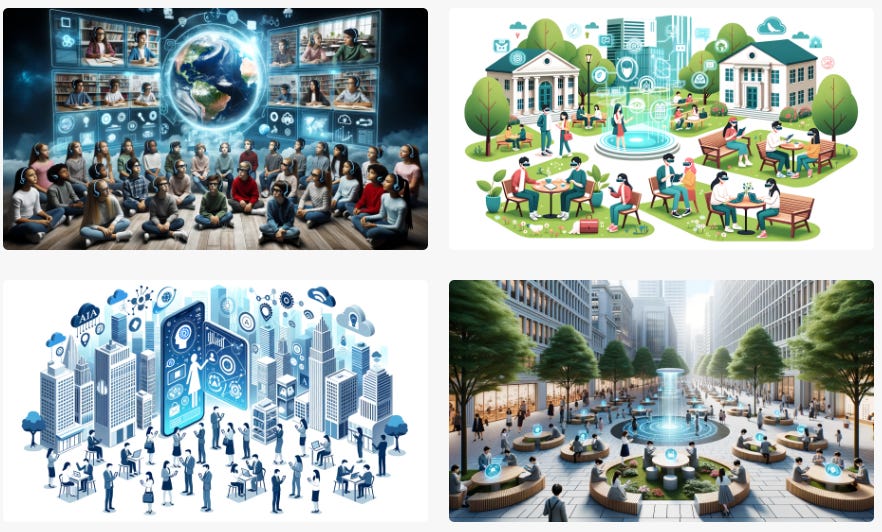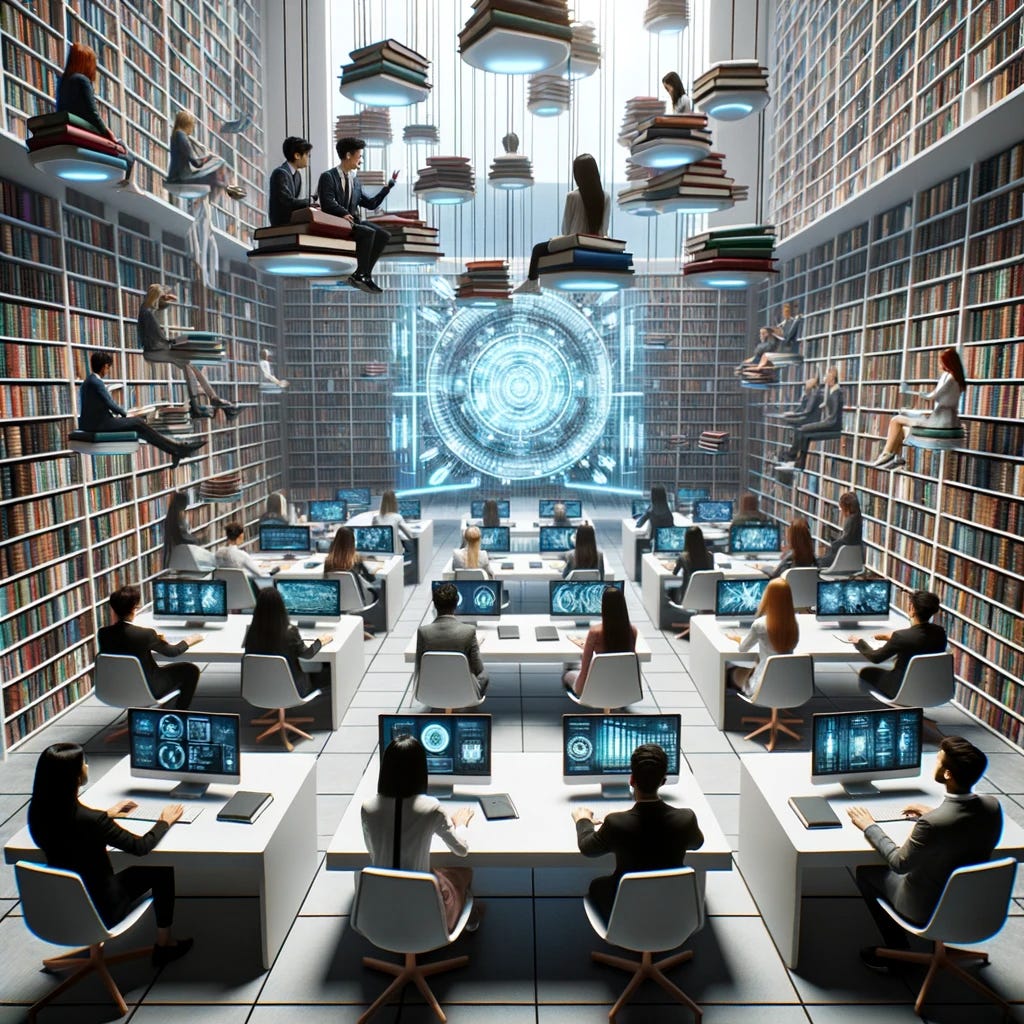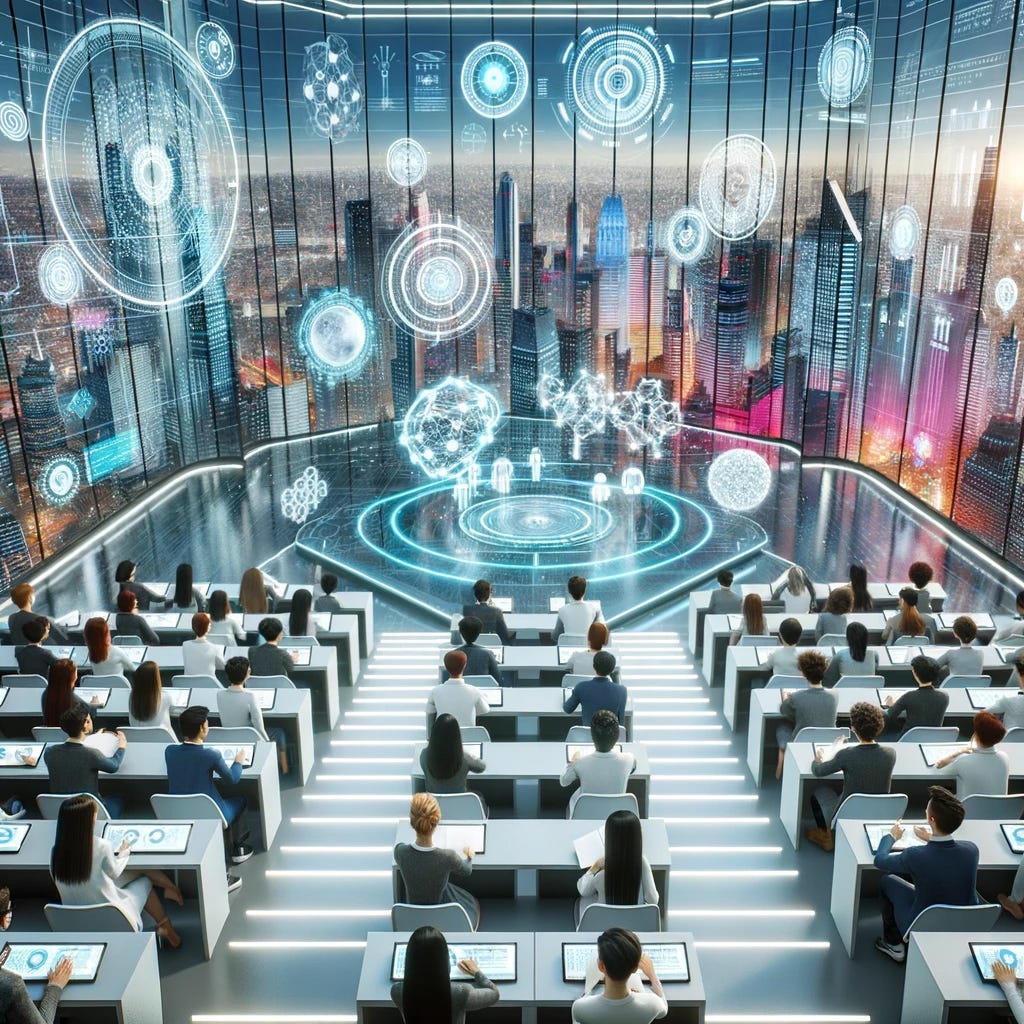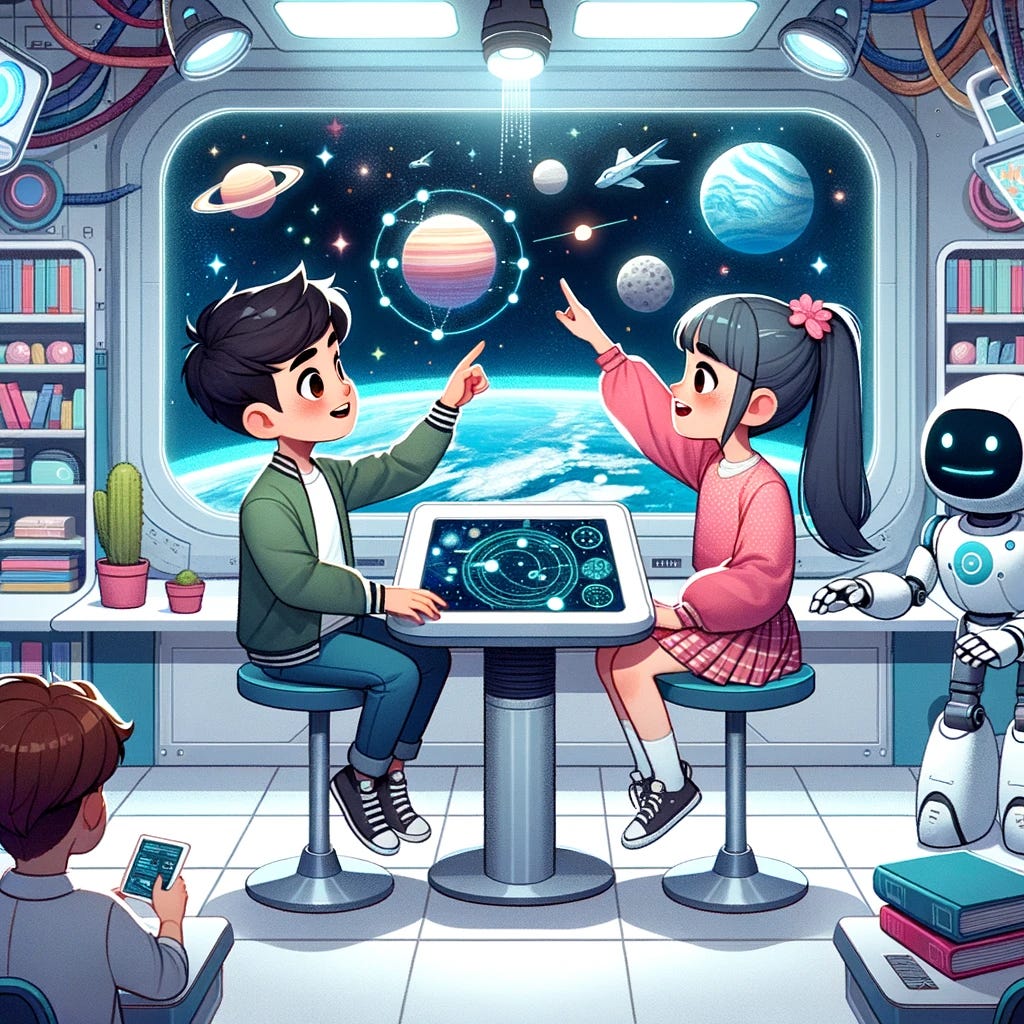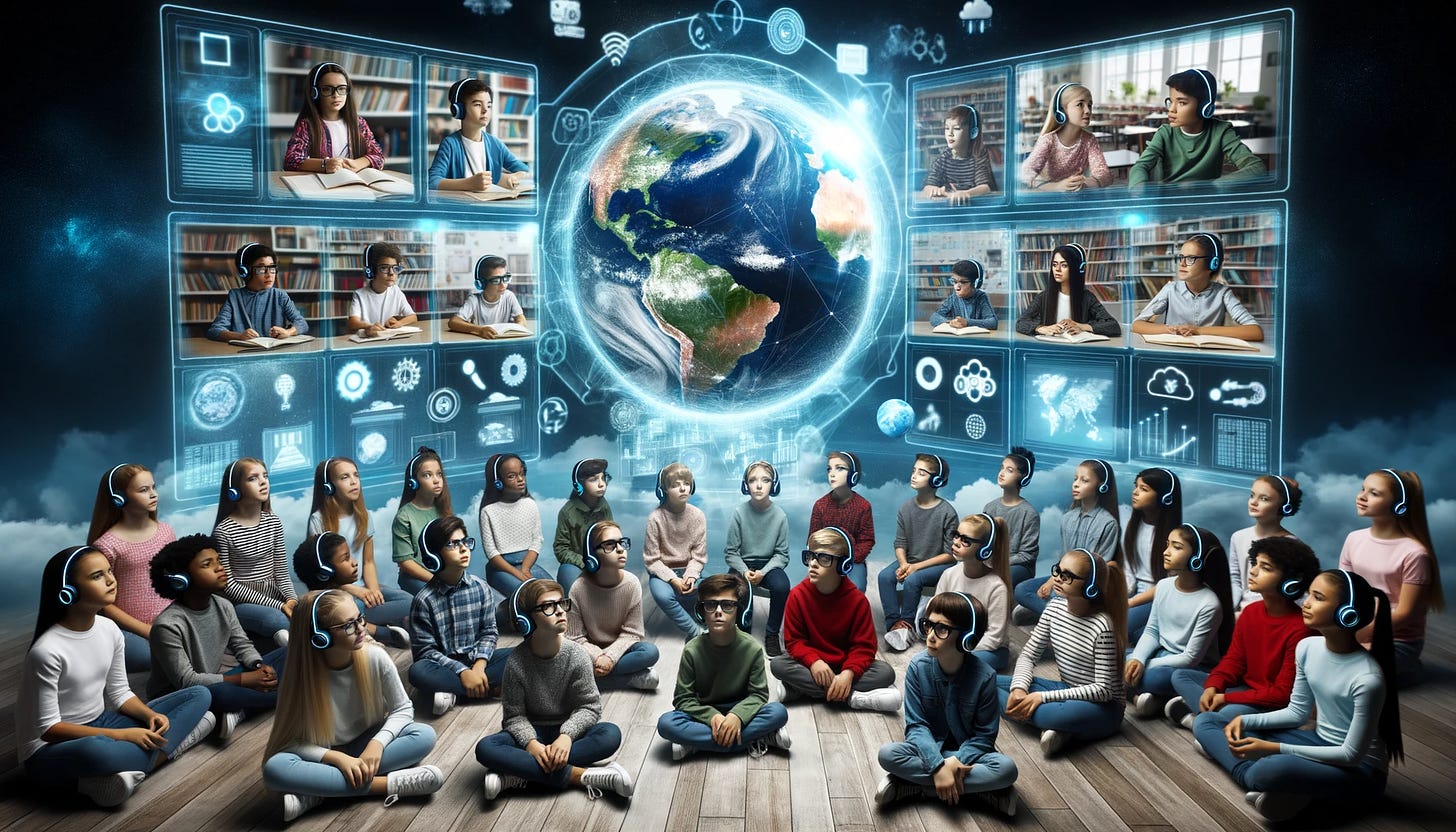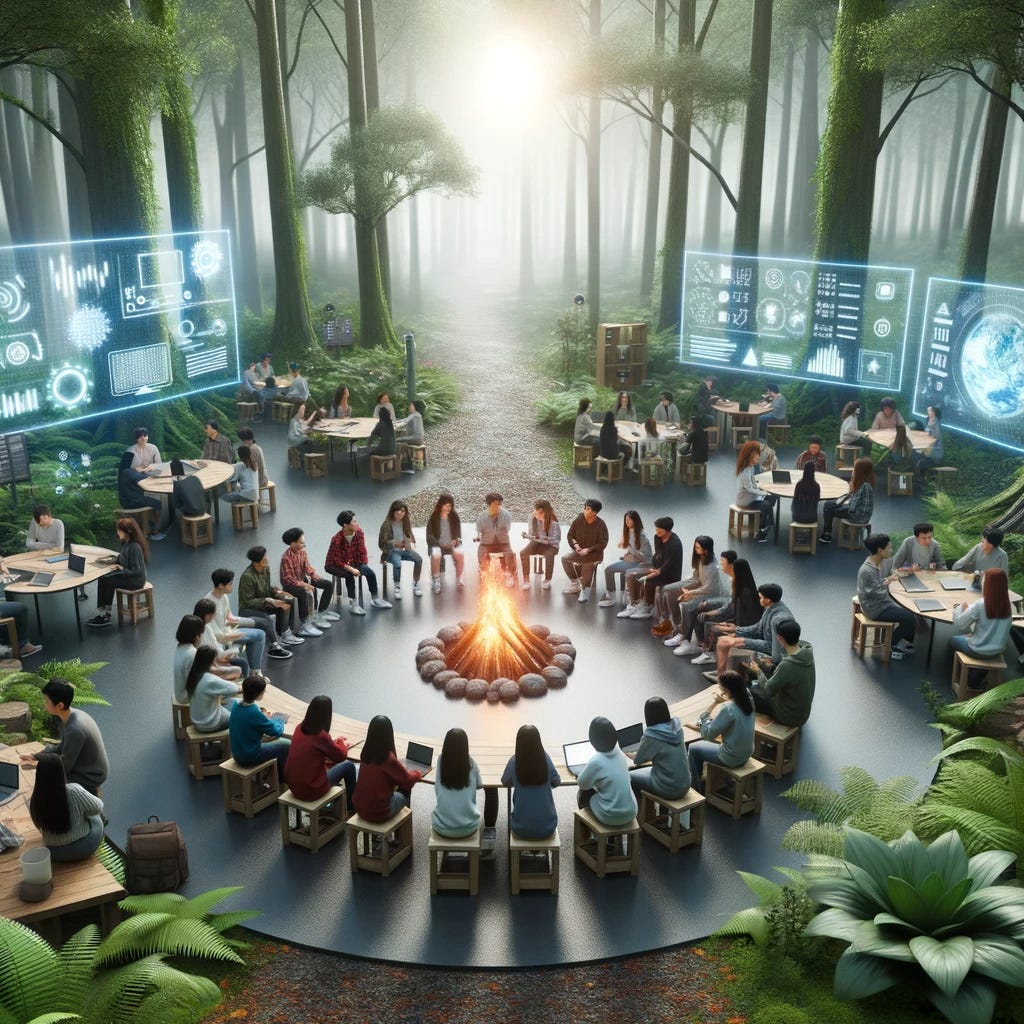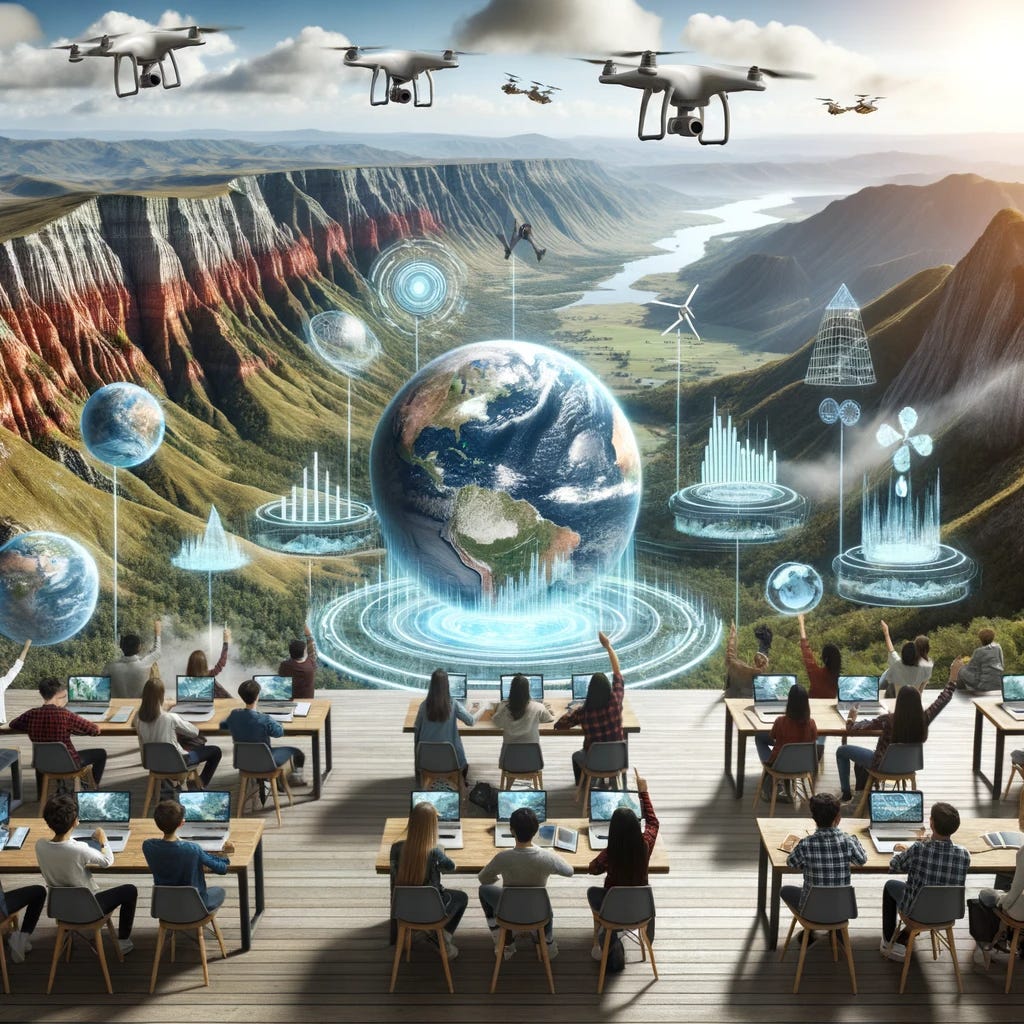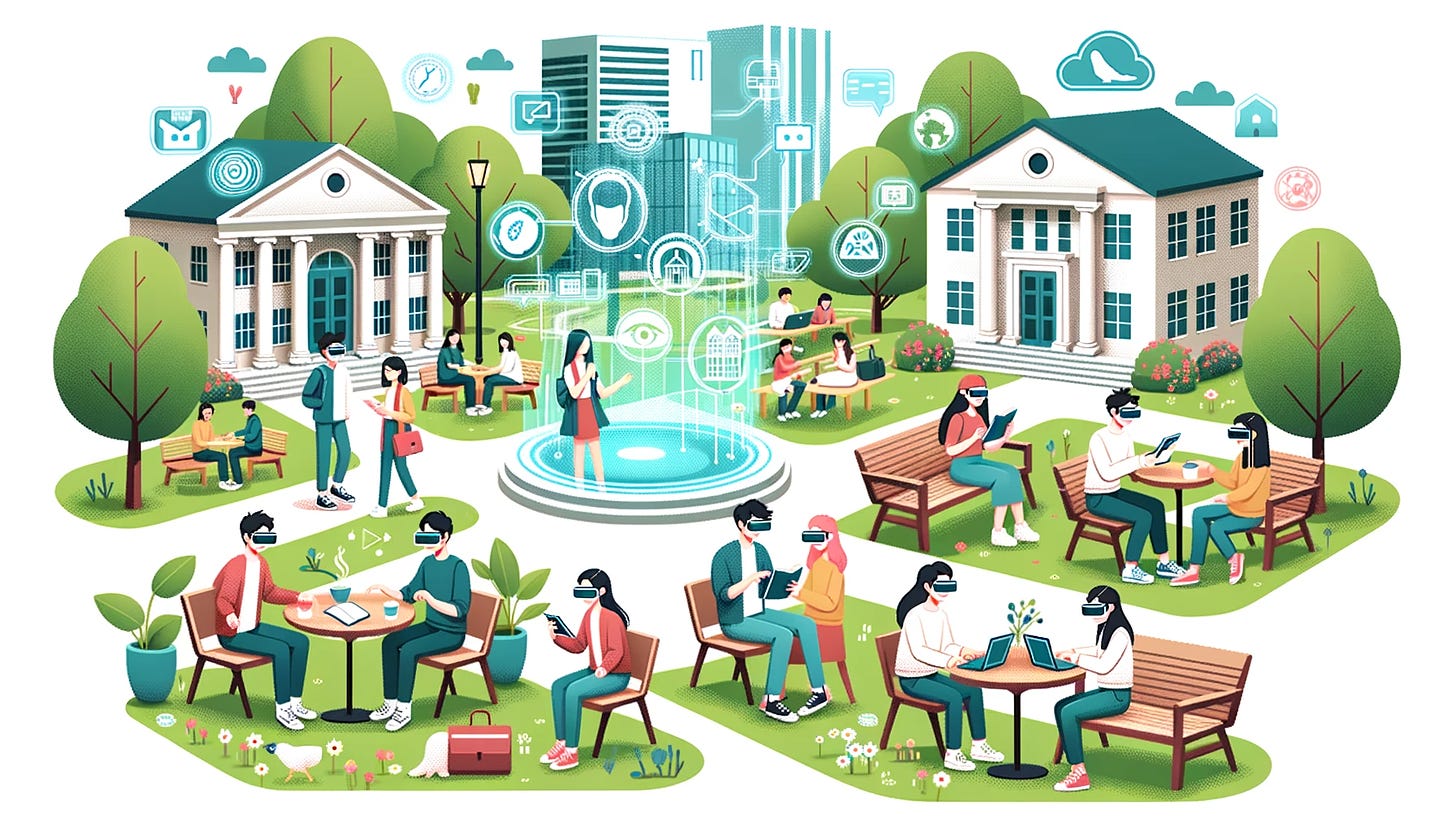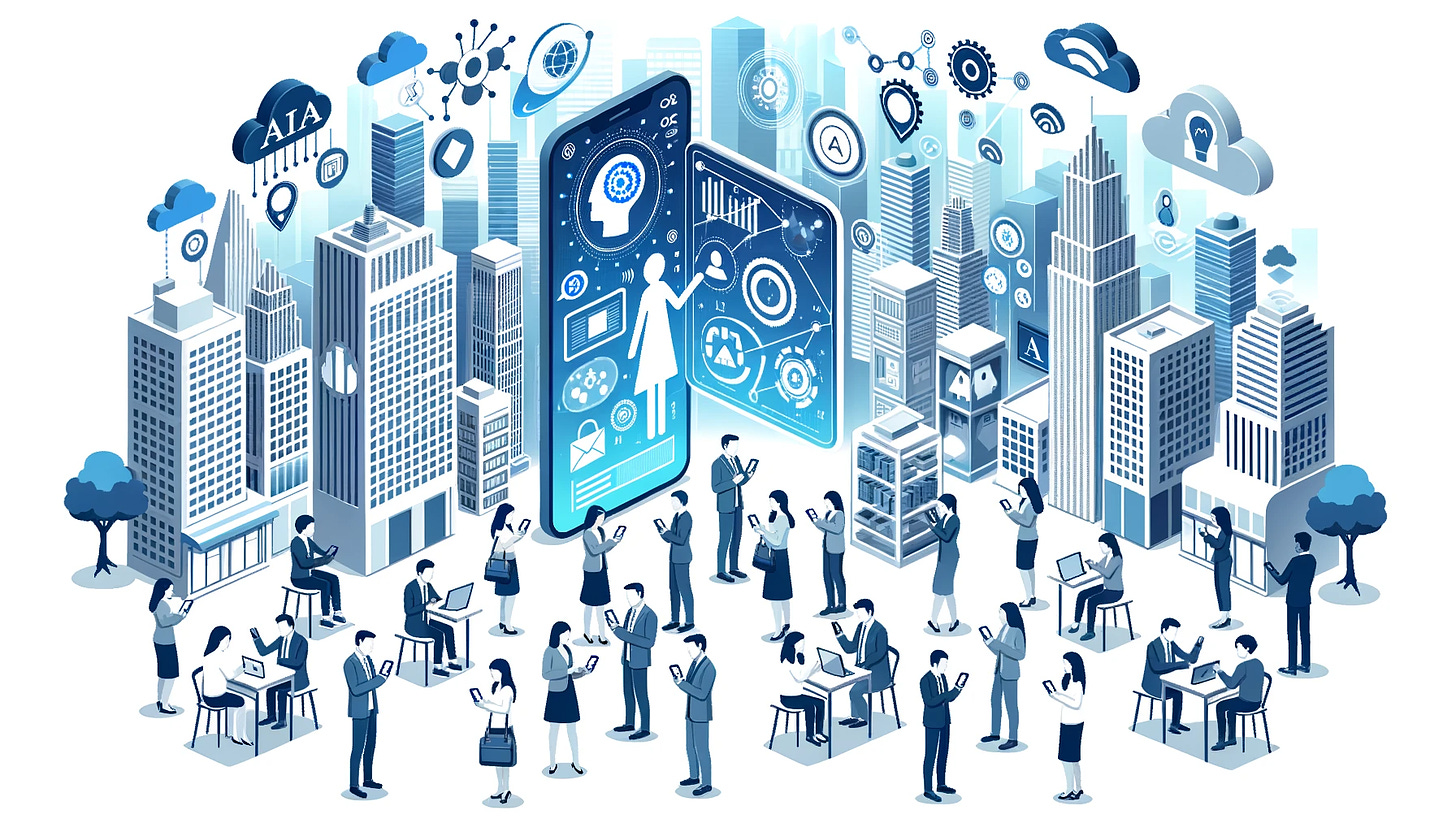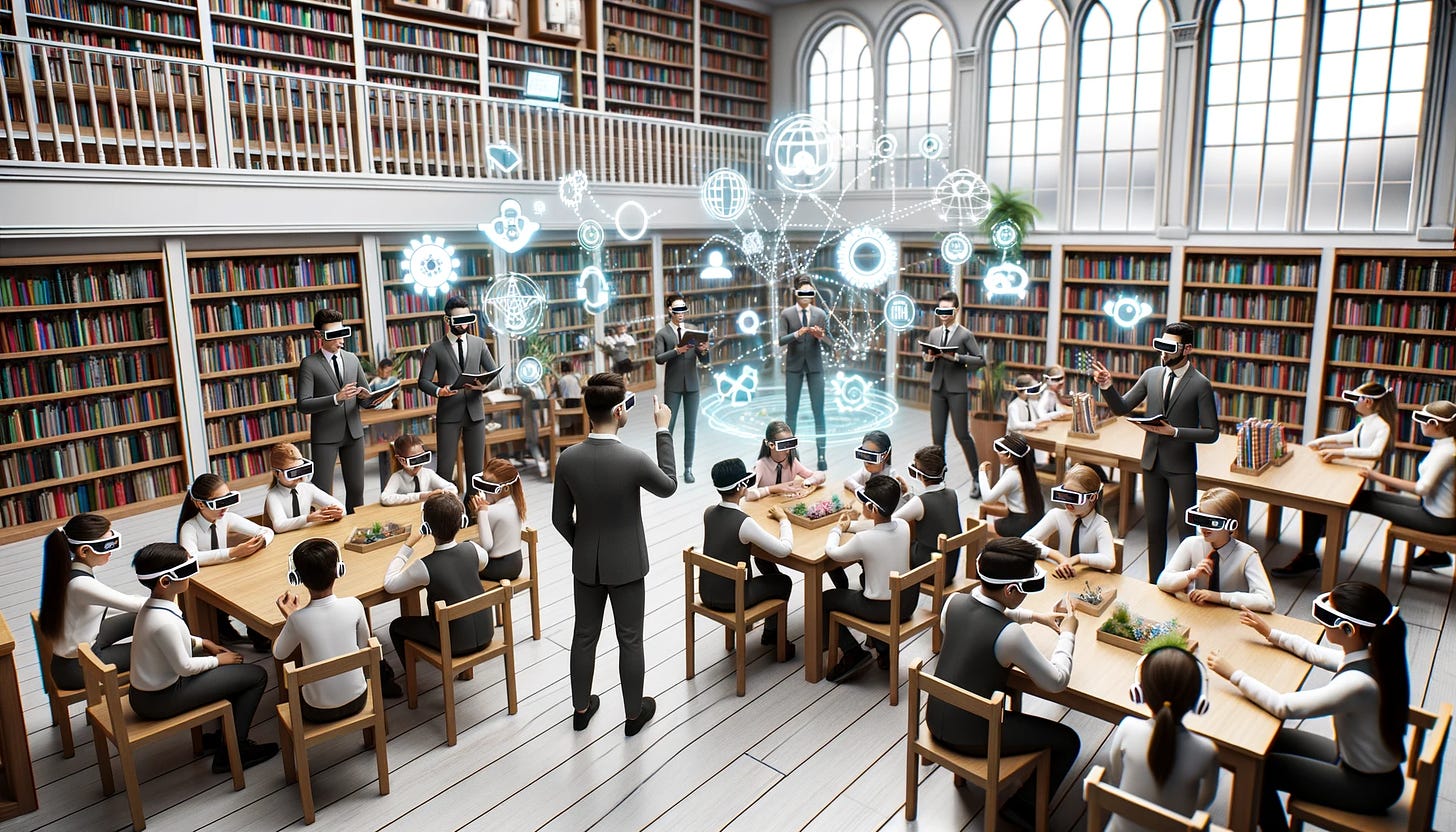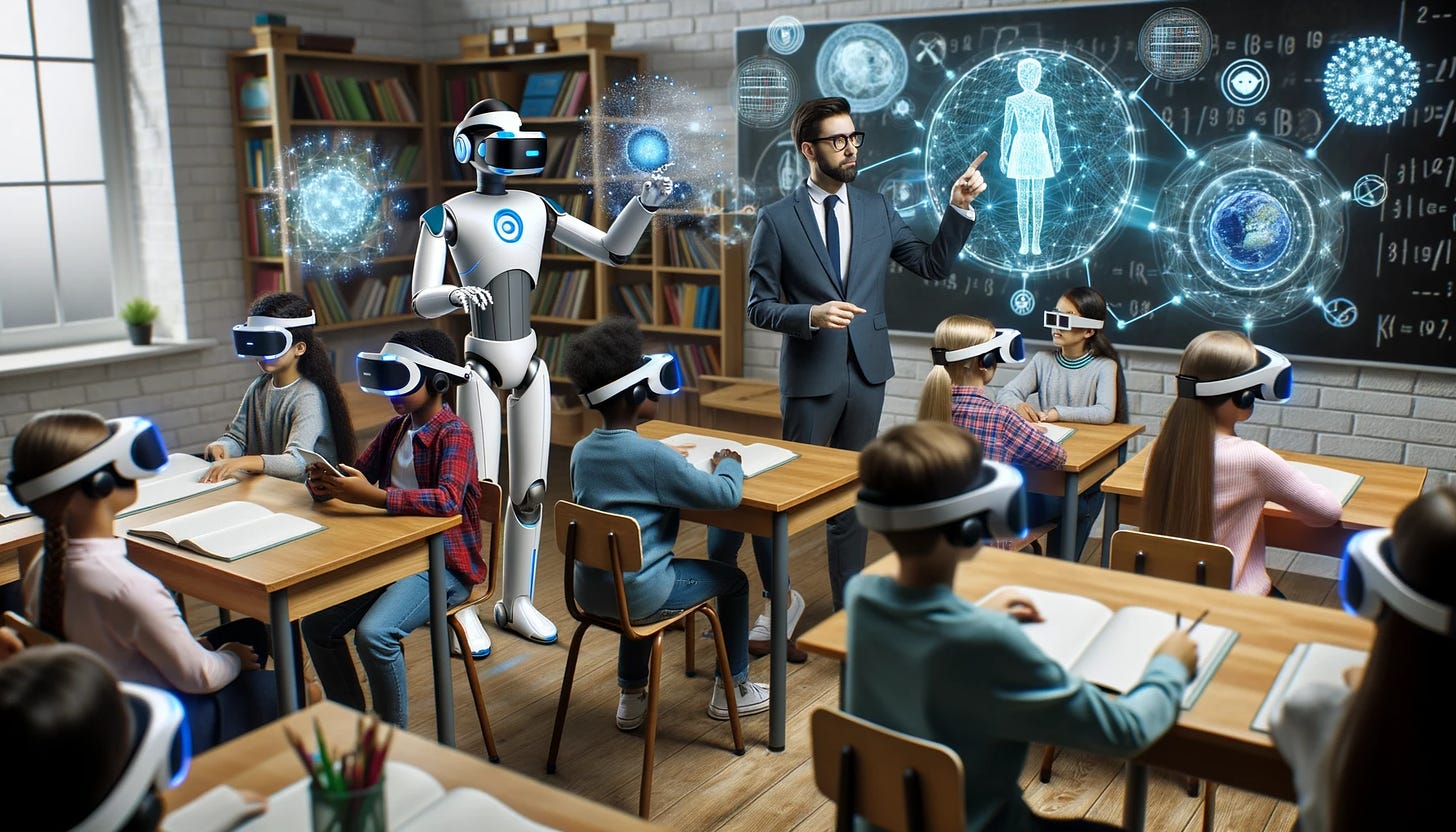What does the future of education LOOK like?
Diverse students receive instruction from robots in an online classroom that mimics the current structure of education.
TL;DR: Diverse students receive instruction from robots in an online classroom that mimics the current structure of education.
____________________________________________________________________________
All of us who have thought about and written about the (immediate) future of education have used AI image generators to generate pictures that go with our posts.
Since we are well aware that these images are generated using common representations of how things have been visually represented and now written about in the past, we know we have to use the best detailed prompts possible to capture what we are actually thinking. We know, for example, that teachers and students aren’t only white and that we often have to include a request to generate teachers and students of different races and genders.
But what are some common ways machines are thinking about the future of education—the machines that are generating the representations many of us internalize? Until today, we just had to guess, but we didn’t really know. But now, since the Dalle-3 image generator in ChatGPT4 takes our initial prompt and adds text to it to generate an image, let’s see what we get for both images based on what details the machines add to our prompts to generate what we think we want to see.
Before each image, I write what I saw in the generated image. After each image, I show what ChatGPT4/Dalle-E3 tried to represent and offer some reflection on that. I didn’t look at the ChatGPT4/Dalle-E3 extended prompts until I formed my own thoughts about the image.
I think this image shows students in a quasi-traditional library using computers where others appear to be working outside the classroom yet connected to the students and instruction in the library.
The library image is arguably important, as it could represent students learning about any subject. Since subject-area expertise may decline in importance, students could be anywhere.
This photo resulted when ChatGPT4/Dall-E3 took my query and on its own expanded it to, ‘Photo of a modern library where books float and arrange themselves based on a student's study preference. Students of diverse descent and gender sit at ergonomic desks, receiving lessons through holographic projections’
Yes, there is no human teacher present, at least physically (a hologram can be a digital representation of an actual human).
Does this “study preference” include studying from home and from different geographic areas?
(2) This second image puts students outside studying “in nature,” which is important, as we’ll all need a break from our technology. It is interesting to me because there is no school or school building retained. Students simply study in a “distributed” manner.
What is arguably concerning is that not only is there no human teacher, but the AIs/robots are portrayed as being “overlords” who appear to direct the instruction (see the “drone”) while other robots stand by either as assistants or enforcers (we don’t know). At the very least, this image seems to reinforce the “grammar” of schooling, where the teacher, now an AI, is the “sage on the stage” and the students are not empowered agents of their own learning.
This photo resulted when ChatGPT4 took my query and on its own expanded it to a “photo of a serene outdoor learning space, where students of diverse descent and gender participate in a hands-on agriculture lesson. Advanced robots assist them, while a drone live-streams the session to students worldwide..…”
I hadn’t caught on to ChatGPT4 adding ‘agriculture’ to the lesson, but since that’s the case, it brings up a couple points.
ChatGPT4 may “understand” the importance of “experiential” education (Korb)
Two, it really does simulate a more conventional educational setting; the only difference is that AI teachers are now in charge of it.
(3) Perhaps I’m being optimistic here, but in this image, I see distributed education where learning is embedded in our day-to-day lives, and we are not even distinguishing between the “school” and the everyday experience. Everyone is learning as part of their daily lives, though there may be some centralized direction. Perhaps the knowledge is “emanating” from somewhere.
This photo resulted when ChatGPT4/Dall-E3 took my query and expanded it to an “illustration of a vast digital campus in a cloud city. Students of different descents and genders navigate through floating platforms, attending virtual lectures and collaborating on holographic projects. Transparent trams connect different parts of the campus.”
In this case, the ChatGPT4/Dall-E3s representation isn’t quite what I saw. It still sees the center area as a “campus” surrounded by a city. I was thinking, maybe hoping, that it was something that was less directed, but I think the prompt basically represents a high-tech campus.
The students are “attending” the “lectures,” but do “collaborate.”
(4) In this picture, I see a very traditional classroom that simply replicates the existing grammar of education: the “sage” on the stage. The only difference is that the human sage is swapped out for either an AI or a hologram of an individual. It also includes the most high-tech “Smart Board” or “Promethean Board” I’ve ever seen.
Shrug. This image uses AI to replicate everything that is wrong with education.
ChatGP4/Dall-E3 and I agree on this one: “Photo of a futuristic lecture hall where students of diverse descent and gender engage with floating 3D diagrams. The hall has transparent walls, showing a vibrant city outside, and students take notes using holographic keyboards.”
(5) For me, this picture represents some optimism. I see two students working together with a friendly AI/robot companion and another friend to learn about something, perhaps the solar system. They are working and learning (hopefully) together, and they are both engaged and happy.
We don’t know if this is student-directed or teacher-directed, but we obviously still need some teachers giving direction.
ChatGPT4/Dall-E3 and I were closely, but not entirely, aligned on this one. It expanded my prompt to portray an “illustration of a young boy of Hispanic descent and a young girl of Middle Eastern descent, studying in a space station classroom. They interact with virtual celestial bodies, while a robot teacher assists them.”
I didn’t think the classroom was a spaceship. I suppose a spaceship represents the “future,” but hopefully we will not have destroyed the earth and have to live in a spaceship.
I also don’t think the boy is “Middle Eastern” and the girl is “Hispanic,” but perhaps those thoughts rely on my own stereotypes, which shows how complicated those questions can be.
I thought the robot was a “fellow student” and not a “robot teacher."
Finally, I’ll note that even in a "spaceship,” it retained the notion of a “classroom.” This “classroom” grammar will be hard to escape, even in what is potentially a “Cambrian explosion.”
(6) I guess we now have the mega classroom. Perhaps it’s the place where all the students hang out together and learn on their own devices with a few human teachers who circulate the room, managing human needs (“Can I go to the bathroom?" | “Johnny just punched me.” | Alex is trying to “Jule”). They get some overarching advice from those “magic” “Smart” boards and “Promethean” boards.
ChatGPT4/Dalle-E3 seemed to agree with what I thought, representing a “drawing of a spherical classroom in a floating city. Inside, diverse students work on collaborative projects using augmented reality. The exterior of the sphere displays their progress to the outside world.”
(7) I think there are a few unique attributes in this photo.
First, no one is on a screen.
Second, they are all listening.
Third, there is no teacher (human or AI) physically present. I was wrong.
Fourth, the global has connections among points (see “nodes” and “Connectivism” in “Generativism”). See high school student Sebastian Rao’s articulation of this.
Fifth, some are physically present, and some are virtually present.
Are you wondering how the learning is directed? Why are you wondering that? Does it matter?
ChatGPT4/Dall-E3 and I are almost on the same page: “photo of a diverse group of K-12 students in different locations, connected via holographic displays showing lessons, interacting in real-time without headsets.”
I say almost because the “lessons” are on the holographic displays. I hadn’t thought of them learning a “lesson” “without” a human teacher or an AI teacher.
(8) The students are outside (great; see above). Some are talking to each other without machines or computers (my father would have been so excited). There is no teacher present, though perhaps they are viewing their “lessons” on the holographic screens.
ChatGPT4/Dalle-E3 say, “photo of a communal learning space in a lush forest. Students of various descents and genders gather around digital campfires, sharing knowledge and experiences, while wearable tech translates languages in real-time..”
“Sharing knowledge and experiences…” It seems we have students as agents driving their own education.
(9). What the hell is this? Students in a traditional learning environment who are constantly monitored by their AI overlords while they view holographic images of augmented reality through their most recent Meta Ray Ban glasses without any human teacher. The green grass is nice, but the rest of this is sort of unsettling.
ChatGPT4/Dall-E3 say: “photo of a mountaintop classroom with panoramic views. Diverse students use augmented reality to study geology and ecology. Floating holographic charts depict the Earth's layers, while drones capture real-time data.”
So, yes, a traditional classroom where we use some augmented reality so students can get some “real world” experience while the drones collect “real time data.” On the students? What happens to it?
(10) Have we all died and largely gone to education heaven, where all students work together in groups that AIs facilitate? Are the physical books supposed to be tossed aside? No human teachers appear to be present.
ChatGPT4/Dall-E3: “photo of an expansive digital library in the sky. Cloud platforms serve as reading areas where students of diverse descent and gender access information through holographic books. Robotic assistants guide students to relevant resources.”
While we have no teachers present, we do have “robotic assistants” guide students. The role of the teacher switches from “sage on the stage” to “guide on the side,” but the guide is now an AI and not a human.
Concluding Remarks
(1) AI companies know we want “diversity.” In 7 of the 10 instances, ChatGPT4/Dall-E3 inserted the word “diverse” into the prompt, and in the other three instances, it added “a young boy of Hispanic descent and a young girl of Middle Eastern descent,” “various descents and genders,” and “different descents and genders.”
My educated guess is that adding this to the prompt was done through a mechanism similar to reinforcement learning with human feedback (RLHF), because while I think humans care about diversity, I don’t think ChatGPT4/Dall-E3 gleamed from human history that we think it’s important in all instances.
Thought Questions
Will all classrooms in the future be diverse? Even if all classrooms of the future will not be diverse, should all representations include a diverse group of students? Who defines diversity? In what ways will they be diverse?
(2) In no instance did ChatGPT4/Dalle-E3 include a human teacher. I don’t think it deliberately chose to exclude human teachers using RLHF. I think it is because those of us who are writing about the future of education and imagining it are imagining it without human teachers.
If we keep doing this, it is going to bake this into the images of the future, and we will, perhaps, create this world as more and more people come to understand the world this way or expect it to be this way.
Simply put, we may be writing and drawing ourselves out of the future, using AI to replace us as we go.Are we going to rely on the folks at OpenAI using RLHF to save us from ourselves?
(3) Despite the lack of human teachers, ChatGPT4/Dalle-E3 imagine a future where students receive ‘lessons’ (#1, #7) or “lectures” (#3) in a “lecture hall” (#2) from either a “robot teacher” #5, a “drone” (#2), or a “holographic projection” (#1).
It is interesting that we’ve mostly replicated the existing “grammars” of schooling while entirely eliminating the human teacher. Hurray! We’ve created the worst of both worlds.
(4) I say “mostly replicated” because students are “sharing knowledge and experience” (#8) and “collaborating” (#3, #6)
(5) I think “wearable tech that translates languages in real time” (#8) is significant because it touches on something I will address in an upcoming paper: people will no longer need to learn languages for the purpose of understanding each other.
(6) Since students are speaking different languages in #8, perhaps they are from different countries. In #2 students participate from across the “world.” That’s one diversity metric, but are they all wealthy? Are they all well-off individuals living in an artificial reality? Is it actually inclusive of everyone?
(7) While we appear to be destroying the earth (climate change, war), the environment of this future is green and lush (#s 2, 8, 9).
___
What do you see in the above pictures?
How do you imagine the future of education? Is it represented here? How would you represent it?
Does relying on image generators that build on the corpus of existing and common representations inherently bind our thinking about the future to the grammars of the past (lectures)? Or does imagining the future without human teachers disprove that?
What do you see in the below pictures? Do (any of) these pictures represent a future you want to see?
How could you use a similar image-generation exercise in your classroom?



